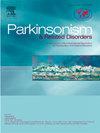Trajectory of change in body mass index in Parkinson's disease
IF 3.4
3区 医学
Q2 CLINICAL NEUROLOGY
引用次数: 0
Abstract
Introduction
Gastrointestinal (GI) symptoms are some of the most common non-motor symptoms in Parkinson's. Weight is a nutritional metric and can be affected by dysfunction of the gastrointestinal (GI) tract. This study aims to explore the change in trajectory of body mass index (BMI) in individuals with Parkinson's over the course of the disease including the prodromal and post-diagnostic periods.
Methods
This was a retrospective longitudinal study of data from participants from the PRIME Parkinson UK cross-sectional study. Participants were included if they had had one or more weights and height recorded in the primary care electronic health record.
Results
287 patients were initially included but only 234 could be included in the analysis of BMI trajectory. Using a piecewise linear mixed model, we determined that there was a ‘change point’ in BMI trajectory. This occurred on average 3.73 years after diagnosis, when the mean BMI was 26.4 kg/m2. Prior to this change point, the estimated mean rate of change in BMI was −0.09 kg/m2 (95 % credible interval −0.20,0.00 kg/m2) per year. However, after the change point, we observed a more accelerated decline in BMI, with an estimated mean rate of change of −0.34 kg/m2 (95 % credible interval −0.70,-0.07 kg/m2) per year.
Conclusion
There was a modest weight loss trajectory in the pre-diagnostic period consistent with clinically stable weight. However, after several years, post-diagnosis BMI loss became more marked. In clinical practice interventions could be targeted at this time point to optimize and maintain nutritional intake.
帕金森病患者体重指数的变化轨迹。
简介:胃肠道症状是帕金森病患者最常见的非运动症状。体重是一项营养指标,可能受到胃肠道功能障碍的影响。本研究旨在探讨帕金森病患者的体重指数(BMI)在病程中的变化轨迹,包括前驱期和诊断后时期:这是一项回顾性纵向研究,研究对象是英国帕金森病 PRIME 横截面研究的参与者。结果:最初纳入了 287 名患者,但只有 234 名患者可纳入 BMI 轨迹分析。我们使用片断线性混合模型确定了 BMI 轨迹的 "变化点"。这个变化点平均出现在确诊后的 3.73 年,当时的平均体重指数为 26.4 kg/m2。在这个变化点之前,BMI 的估计平均变化率为每年-0.09 kg/m2(95 % 可信区间为-0.20,0.00 kg/m2)。然而,在变化点之后,我们观察到体重指数的下降速度加快,估计平均变化率为每年-0.34 kg/m2 (95 % 可信区间-0.70,-0.07 kg/m2):结论:在诊断前期,体重略有下降,与临床体重稳定一致。然而,几年后,诊断后的体重指数下降更为明显。在临床实践中,可以在这个时间点进行有针对性的干预,以优化和维持营养摄入。
本文章由计算机程序翻译,如有差异,请以英文原文为准。
求助全文
约1分钟内获得全文
求助全文
来源期刊

Parkinsonism & related disorders
医学-临床神经学
CiteScore
6.20
自引率
4.90%
发文量
292
审稿时长
39 days
期刊介绍:
Parkinsonism & Related Disorders publishes the results of basic and clinical research contributing to the understanding, diagnosis and treatment of all neurodegenerative syndromes in which Parkinsonism, Essential Tremor or related movement disorders may be a feature. Regular features will include: Review Articles, Point of View articles, Full-length Articles, Short Communications, Case Reports and Letter to the Editor.
 求助内容:
求助内容: 应助结果提醒方式:
应助结果提醒方式:


